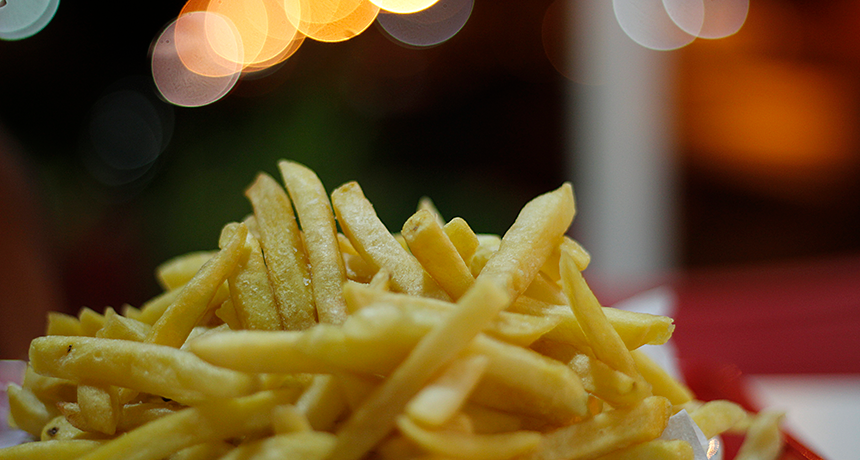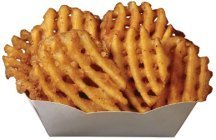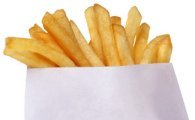In Search of the Perfect French Fry
Scientists are looking for new ways to make french fries that have the proper balance of flavor, texture, and nutrition.

A pile of appetizing french fries.
Morgânia Lima/CC BY-NC-SA 2.0
Share this:
- Share via email (Opens in new window) Email
- Click to share on Facebook (Opens in new window) Facebook
- Click to share on X (Opens in new window) X
- Click to share on Pinterest (Opens in new window) Pinterest
- Click to share on Reddit (Opens in new window) Reddit
- Share to Google Classroom (Opens in new window) Google Classroom
- Click to print (Opens in new window) Print
By Emily Sohn
The perfect French fry means different things to different people. You might like them McDonald’s-style: straight, skinny, and golden brown. But you probably know people who like the spicy kind that twist around like corkscrews.
I’m among the minority: My favorite french fries are thick, homemade, and full of steamy potato flavor with the skins left on.
 |
|
French fries come in all sorts of flavors and shapes.
|
Fighting over the meaning of french-fry perfection may seem like a silly thing to do. But the stakes are huge: People spend more than $75 billion on fried foods every year.
Yet those same foods have a terrible reputation among nutritionists. The more fried foods Americans eat, the fatter they get, and the more likely they are to develop diabetes, heart disease, and other health problems.
Two teenagers in New York even tried to sue McDonald’s recently for making them fat. The case was dismissed, but the problem remains: Is it possible to make a yummy french fry that’s also good for you?
Building better fries
Now, after years of careful observation and experimentation, research is showing that maybe we can have our fries and eat them, too.
Using basic principles of chemistry and engineering, scientists are finding new ways to make better fries that strike a balance among flavor, texture, and nutrition. Their work may eventually propel french fries into a more modern version of perfection.
Next time you’re in a fast food restaurant, watch carefully as the fry cook plunges a batch of uncooked potato strips into the fryer.
On a typical day at McDonald’s, oil temperature in the fryer averages a steamy 340°F. The potatoes—which are usually partially pre-fried and then frozen—are much colder than that. So when the cook throws them in, water inside the potatoes starts to boil immediately, and bubbles rise to the surface.
As water evaporates from the potatoes, holes open up for oil to creep in, and a crust forms from the outside in. The crust soon approaches the temperature of the oil, while the soft interior of the potato continues to hover at about 212°F, the boiling point of water.
During the 3 minutes or so of deep frying, you can watch the bubbles rise slowly at first, then a little faster, then slower again in an enormous cycle that scientists call “heat transfer.” Without it, a potato will always be just a potato.
“We feel very strongly that this dynamic, variable heat transfer is one of the primary things that makes frying unique and leads to those products we love,” says Brian Farkas, a food engineer at North Carolina State University.
Oil as the culprit
Oil has traditionally been the secret behind making a fantastic fry. Oil tastes good, and it gives fries the kind of texture, or “mouth feel,” we find so pleasing.
But from a health standpoint, oil is the enemy—loaded with calories, fats, and cholesterol. As much as 20 percent of a french fry’s calories come from oil.
 |
|
A tempting bag of tasty but low-nutrient french fries.
|
So for years, scientists have been trying to mimic the heat transfer of the frying process without using oil. Results have been only so-so.
One major focus of oil-free research has involved blasting a partially fried potato with fast-moving air as hot as 400°F or 500°F, using a hair-dryer-like machine. The Ore-Ida Company even developed a french-fry vending machine based on the technique.
“They weren’t too bad,” Farkas says hesitantly, but they weren’t too good, either. “The problem is that when you blow hot air across the fries, you blow the oil off, and you make a mess. You don’t get the kind of heat transfer unique to frying.”
Some scientists have tried using chemically engineered, low-fat oils such as Olestra to make healthier fries. But those oils have come under fire for being impossible to digest, and they’re expensive to make.
Other researchers have been working to make edible coatings that keep oil from penetrating the potatoes.
Another idea on the table is to pack potatoes full of vitamins, through engineering or other processes, says Michael Blumenthal, an ex-oil chemist who is now a food consultant.
Fortified fries
Surveys have shown that one-third of vegetables eaten by pre-teens and one-quarter eaten by teenagers in the United States are potatoes, Blumenthal says, most of which are fried.
“That’s unbelievable,” he says. “There are not many nutrients in french fries. So if that’s the way society is going, then just like bread, french fries should be fortified.”
Perhaps the most promising new technique for making fries that are good and good for you involves infrared energy—the kind emitted by a heat lamp.
By zapping potatoes with infrared energy at high enough intensities, Farkas says he can turn a tuber into a pile of ash in minutes. But by controlling the level of intensity to mimic the heat transfer involved in frying, it might be possible to produce more perfect fries.
“In the end,” he says, “they will hopefully have lower oil content and all the desirable qualities of french fries.”
Taste test
In a McDonald’s restaurant in California a while back, one stringy-haired, 10-year-old girl didn’t hesitate for a second to give me her opinion about perfection in the french fry world.
“McDonald’s are the best because they’re salty and good,” she said. Sometimes kids know things in a way that scientists can’t match.
Going Deeper:
News Detective: Emily investigates french fries







